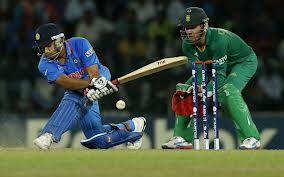I once met an American friend in New York who was curious about the game of cricket. He couldn’t understand how a game could last five days and yet still end in a draw.
The peculiarities of the Test match has come under intense scrutiny in recent years as the public vote with their feet and either support the limited over games or more poignantly avoid cricket altogether.
If the latter becomes the norm then surely it is better to keep the game alive by expanding the One Day games – particularly the popular Twenty20 version – rather than see cricket perish in its entirety.
That’s why I find the views of West Indian legends Michael Holding, Viv Richards and Joel Garner to ban international Twenty20 cricket difficult to appreciate. Holding, in particular, has been a vociferous agitator against the Twenty20 version and blames the sport’s governing body, the International Cricket Council (ICC) for not offering a robust enough defence of the Five day game.
Test match cricket is failing not because the ICC isn’t promoting it – in fact in my opinion there is too much Test cricket – but because market forces are demanding a shift in direction. For now, that movement is towards Twenty20 cricket, which since its conception in the early 2000s has brought a new dynamism, fan base and more importantly increased finance to the cricket industry.
Over recent years we have witnessed some thrilling Test matches – who can forget last year’s third Test between India and the West Indies in Mumbai, which ended in a dramatic tie. But outside of the Ashes Series and overseas teams touring England, these matches are played out in front of dwindling crowds with the inevitable decline in match receipts. In fact, if it wasn’t for the monies generated from the limited over variations of the sport, cricket would almost certainly be consigned to the history books.
I’m not advocating the death of Test cricket, far from it. The longer form game still remains the supreme test of ability. But I believe it should accept its secondary role in the eyes of the people who pay to watch it and crucially the sponsors who pay handsomely to have their names associated with the sport.
It’s no surprise that the reason cited for the postponement of the inaugural ICC World Test Championship – a proposed knock out tournament with each game played over five days – until at least 2017 was because the ICC didn’t have the support of its broadcast partner, who believed an international One Day tournament would generate more revenue than a Test World Championship.
To keep Test cricket fresh and appealing I believe that there should be fewer Test series but contests should take place over more matches. Whatever happened to the period when one Test country toured West Indies each season and played five Test matches? The current system of squeezing in two Test playing nations over two or three matches each doesn’t provide an adequate measure as to who is the better side.
By all means have three match series against the lesser teams of Zimbabwe and Bangladesh but all other Test series should be played over five matches. This may prove a logistical nightmare if at present each Test side has to play each other, home and away, in a four year cycle.
But if we can limit the number of Test series it will make it easier to schedule the now dominant and larger revenue producing limited over games. After all it’s what the public and the sponsors are voting for with their hard earned cash. Limited over cricket and particularly Twenty20 cricket is here to stay so let’s embrace it at all levels of the game.





